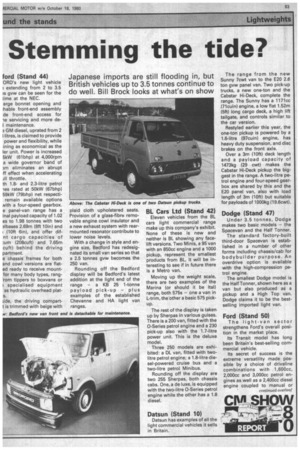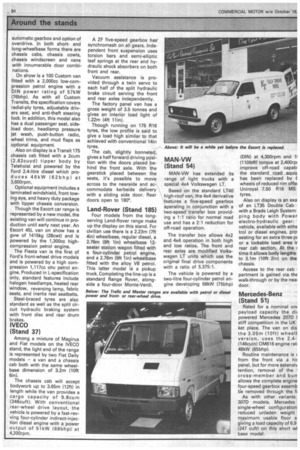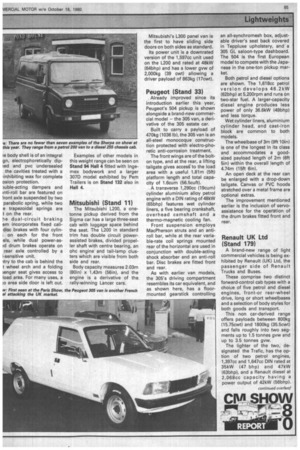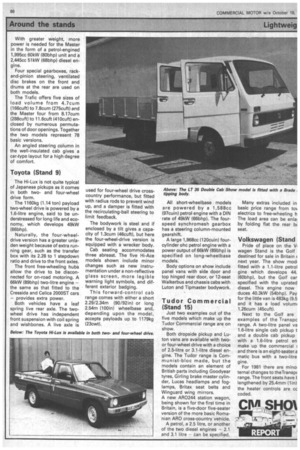Stemming the tide?
Page 85

Page 86

Page 87

Page 88

If you've noticed an error in this article please click here to report it so we can fix it.
Japanese imports are still flooding in, but British vehicles up to 3.5 tonnes continue to do well. Bill Brock looks at what's on show
ford (Stand 44)
ORD's new light vehicle extending from 2 to 3.5 :s gvw can be seen for the time at the NEC.
arge bonnet opening and :hable front-end assembly de front-end access for ie servicing and more de1 maintenance.
3 GM diesel, uprated from 2 I litres, is claimed to provide power and flexibility, while ining as economical as the ler unit. Power is increased 5kW (61bhp) at 4,000rpm a wide governor band of )m eliminates an abrupt ft effect when accelerating ill throttle.
th 1.8and 2.3-litre petrol les rated at 50kW (67bhp) 59kW (79bhp) net respectiremain available options Nith a four-speed gearbox. e panel-van range has a inal payload capacity of 1.02 es to 1.98 tonnes with two .1bases 2.69m (8ft 10in) and
(10ft 6in), and offer difnt cargo capacities of ;urn (208cuft) and 7.65m cuft) behind the driving partment.
e chassis frames for both and cowl versions are flated ready to receive mountfor many body types, rang:rom tippers to boxvans or specialised equipment as hydraulic overhead plats.
;icle, the driving compartt is trimmed with beige with plaid cloth upholstered seats. Provision of a glass-fibre removable engine cowl insulator and a new exhaust system with rearmounted resonator contribute to lower noise levels.
With a change in style and engine size, Bedford has redesignated its small van series so that a 2.5 tonnes gvw becomes the 250 van.
Rounding off the Bedford display will be Bedford's latest addition at the light end of the range — a KB 25 1-tonne payload pick-up — plus examples of the established Cheyenne and HA light van ranges.
BL Cars Ltd (Stand 42)
Eleven vehicles from the BL cars light commercial range make up this company's exhibit. None of these is new and neither is BL showing any facelift versions. Two Minis, a 95 van with an 850cc engine and a 1000 pickup, represent the smallest products from BL. It will be interesting to see if in future there is a Metro van.
Moving up the weight scale, there are two examples of the Marina (or should it be !tat) range, both 575s — one a van in L-trim, the other a basic 575 pickup.
The rest of the display is taken up by Sherpas in various guises. There is a 200 van, fitted with the 0-Series petrol engine and a 230 pick-up also with the 1.7-litre power unit. This is the deluxe model.
Three 250 models are exhibited: a DL van, fitted with twolitre petrol engine; a 1.8-litre diesel-powered cruise bus and a two-litre petrol Minibus.
Rounding off the display are two 255 Sherpas, both chassis cabs. One, a de luxe, is equipped with the two-litre 0-Series petrol engine while the other has a 1.8 diesel,
Datsun (Stand 10)
Datsun has examples of all the light commercial vehicles it sells in Britain. The range from the new Sunny 7cwt van to the E20 2.6 ton gvw panel van. Two pick-up trucks, a new one-ton and the Cabstar Hi-Deck, complete the range. The Sunny has a 1171cc (71cuin) engine, a low flat 1.52m (5ft) long cargo deck, a high lift tailgate, and controls similar to the car version.
Restyled earlier this year, the one-ton pickup is powered by a 1.6-litre (97cuin) engine, has heavy duty suspension, and disc brakes on the front axle.
Over a 3m (10ft) deck length and a payload capacity of 1473kg (29 cwt) makes the Cabstar Hi-Deck pickup the biggest in the range. A two-litre petrol engine and four-speed gearbox are shared by this and the E20 panel van, also with load length of 3m (10ft) but suitable for payloads of 1000kg (19.6cwt).
Dodge (Stand 47)
Under 3.5 tonnes, Dodge makes two basic models — the Spacevan and the Half Tonner.
The standard factory-built third-door Spacevan is established in a number of other forms including chassis/cab for bodybuilder purpose. An overdrive option is available with the high-compression petrol engine.
The smallest Dodge model is the Half Tonner, shown here as a van but also produced as a pickup and a High Top van. Dodge claims it to be the bestselling imported light van.
Ford (Stand 50)
The light-van sector strengthens Ford's overall position in the market place.
Its Transit model has long been Britain's best-selling commercial vehicle.
Its secret of success is the extreme versatility made possible by a choice of driveline combinations with 1,600cc, 2,000cc and 3,000cc petrol engines as well as a 2,400cc diesel engine coupled to manual or automatic gearbox and option of overdrive. In both shortand long-wheelbase forms there are chassis cabs, chassis cowls, chassis windscreen and vans with innumerable door combinations.
On show is a 100 Custom van fitted with a 2,000cc low-compression petrol engine with a DIN power rating of 57kW (7613hp). As with all Custom Transits, the specification covers radial-ply tyres, adjustable drivers seat, and anti-theft steering lock. In addition, this model also has a dual passenger seat, sideload door, headlamp pressure jet wash, push-button radio, wheel trims, and mud flaps as optional equipment.
Also on display is a Transit 175 chassis cab fitted with a 2cum (2.62cuyd) tipper body by Telehoist and powered by the Ford 2.4-litre diesel which produces 46 kW (6 2 bhp) at 3,60Orpm, Optional equipment includes a laminated windshield, front towing eye, and heavy duty package with tipper chassis conversion.
Though the Escort car range is represented by a new model, the existing van will continue in production until early next year. An Escort 45L van on show has a gvw of 1415kg (28cwt) and is powered by the 1,300cc highcompression petrol engine.
The Fiesta van is the first of Ford's front-wheel drive models and is powered by a high compression 1,117cc ohc petrol engine. Produced in L-specification only, standard features include halogen headlamps, heated rear window, reversing lamp, fabric seats, and inertia reel seatbelts.
Steel-braced tyres are also standard as well as the split circuit hydraulic braking system with front disc and rear drum brakes.
IVECO (Stand 37)
Among a mixture of Magirus and Fiat models on the IVECO stand, the light end of the range is represented by two Fiat Daily models — a van and a chassis cab both with the same wheelbase dimension of 3.2m (10ft 6in).
The chassis cab will accept bodywork up to 3.65m (12ft) in length while the van provides a cargo capacity of 9.8cum (346cuft). With conventional rear-wheel drive layout, the vehicle is powered by a fast-revving four-cylinder indirect-injection diesel engine with a power output of 51 kW (69bhp) at 4,20Orpm. A ZF five-speed gearbox has' synchromesh on all gears. Independent front suspension uses torsion bars and semi-elliptic leaf springs at the rear and hydraulic shock absorbers on both front and rear.
Vacuum assistance is provided through a twin servo to each half of the split hydraulic brake circuit serving the front and rear axles independently.
The factory panel van has a gross weight of 3.5 tonnes and gives an interior load light of 1.22m (4ft 11in).
Though running on 175 R16 tyres, the low profile is said to give a load high similar to that achieved with conventional 14in tyres.
The cab, slightly bonneted, gives a half forward driving pOsition with the doors placed ',behind the front axle, With the gearstick placed between the seats, it's possible to move across to the nearside and accommodate kerbside delivery with a sliding side door. Rear doors open to 180°.
Land-Rover (Stand 185)
Four models from the longserving Land-Rover range make up the display on this stand. For civilian use there is a 2.23m (7ft 4in) wheelbase, regular diesel, a 2.76m (9ft 1in) wheelbase 12seater station wagon fitted with a four-cylinder petrol engine, and a 2.76m (9ft 1 in) wheelbase fitted with the alloy V8 petrol. This latter model is a pickup truck. Completing the line-up is a standard Range Rover, alongside a four-door Monte-Verdi.
MAN-VW (Stand 54)
MAN-VW has extended its range of light trucks with a special 4x4 Volkswagen LT.
Based on the standard LT40 high-roof van, the 4x4 derivative features a five-speed gearbox pperating in conjunction with a two-speed transfer box providing a 1:1 ratio for normal road use and has a 2:1 reduction for off-road operation.
The transfer box allows 4x2 and 4x4 operation in both high and low ratios. The front and rear axles are modified Volkswagen LT units which use the original final drive components with a ratio of 5.375:1.
The vehicle is powered by a two-litre four-cylinder petrol engine developing 56kW (75bhp) (DIN) at 4,300rpm and 1! (110Ibft) torque at 2,400rpi improve off-road capabi the standard _r_oadaqui_p has been replaced by wheels of reduced rim offs( Uniroyal 7.50 R16 MS tyres.
Also on display is an exa of an LT35 Double Cab with a Brade Leigh System ping body with Power electro-hydraulic gear. vehicle, available with eithE trol or diesel engines, pro' seating for an extra three p( or a lockable load area ir rear cab section. At the time it allows body lengths to 3.1m (10ft 2in) on the chassis.
Access to the rear cab partment is gained via, the walk-through or by the nee' door.
Mercedes-Benz (Stand 51)
Rated for a nominal on( payload capacity the di( powered Mercedes 207D stiff competition in the UK ket place. The van on dis the 3.05m (10ft) wheelt version, uses the 2,4(146cuin) 0M616 engine rat 48kW (65bhp).
Routine maintenance is from the front via a hi, panel, but for more extensiv tention, removal of the cross-member and burr allows the complete engine four-speed gearbox assemb be removed through the fi As with other variants 307D models, Mercedes single-wheel configuration reduced unladen weight maximum usable floor s giving a load capacity of 6.9 (247 cuff) on this short wl base model. le body shell is of an integral gn, electrophoretically dipled and pvc undersealed the cavities treated with a -inhibiting wax for complete osion protection.
)uble-acting dampers and inti-roll bar are featured on front axle suspended by two parabolic spring, while two e trapezoidal springs are i on the rear.
he dual-circuit braking em incorporates fixed calidisc brakes with four cylin. on each for the front els, while dual power-as;c1 drum brakes operate on rear axle controlled by a I-sensitive unit.
;try to the cab is behind the t wheel arch and a folding ;enger seat gives access to load area. For many uses, a lo area side door is left out. Examples of other models in this weight range can be seen on Stand 94 Hall 4 fitted with Ingemex bodywork and a larger 307D model exhibited by Pem Trailers is on Stand 132 also in Half 4.
Mitsubishi (Stand 11)
The Mitsubishi L200, a onetonne pickup derived from the Sigma car has a large three-seat cab with luggage space behind the seat. The L200 in standard trim has double circuit powerassisted brakes, divided propeller shaft with centre bearing, an ohc engine and tail-lamp clusters which are visible from both side and rear.
Body capacity measures 2.03m (80in) x 1.43m (56m), and the engine is a derivative of the. rally-winning Lancer cars. Mitsubishi's L300 panel van is the first to have sliding side doors on both sides as standard.
Its power unit is a downrated version of the 1,597cc unit used on the L200 and rated at 48kW (64bhp) and has a lower gvw of 2,000kg (39 cwt) allowing a driver payload of 863kg (17cwt).
Peugeot (Stand 33)
Already improved since its introduction earlier this year, Peugeot's 504 pickup is shown alongside a brand-new commercial model — the 305 van, a derivative of the 305 estate car.
Built to carry a payload of 470kg (1036 lb), the 305 van is an all-steel monocoque construction protected with electro-phoretic anti-corrosion treatment.
The front wings are of the bolton type, and at the rear, a lifting tailgate gives acces§to the load area with a useful 1.81m (5ft) platform length and total capacity of 1.6cum (56.5cuft).
A transverse 1,290cc (19cum) cylinder aluminium alloy petrol engine with a DIN rating of 48kW (65bhp) features wet cylinder liners, a five bearing crankshaft, overhead camshaft and a thermo-magnetic cooling fan.
Front suspension employs MacPherson struts and an antiroll bar, while at the rear variable-rate coil springs mounted rear of the horizontal are used in conjunction with double-acting shock absorber and an anti-roll bar. Disc brakes are fitted front and rear.
As with earlier van models, the 305's driving compartment resembles its car equivalent, and as shown here, has a floormounted gearstick controlling an all-synchromesh box, adjustable driver's seat back covered in Teppluxe upholstery, and a 305 GL saloon-type dashboard. The 504 is the first European model to compete with the Japanese in the one-ton pickup market.
Both petrol and diesel options are shown. The 1,618cc petrol version develops 4 6.2kW (62bhp) at 5,200rpm and runs on two-star fuel. A larger-capacity diesel engine produces less power of only 36.6kW (49bhp) and less torque.
Wet cylinder liners, aluminium cylinder head, and cast-iron block are common to both models.
The wheelbase of 3m (9ft 10in) is one of the longest in its class and accommodates a goodsized payload length of 2m (6ft Sin) within the overall length of 4.74m (1511 6in).
An open deck at the rear can be enlarged with a drop-down tailgate. Canvas or PVC hoods stretched over a metal frame are optional extras.
The improvement mentioned earlier is the inclusion of servoassistance for the operation of the drum brakes fitted front and rear,
Renault UK Ltd (Stand 179)
A brand-new range of light commercial vehicles is being exhibited by Renault (UK) Ltd, the passenger side of Renault Trucks and Buses.
These comprise two distinct forward-control cab types with a choice of five petrol and diesel engines, front-or rear-wheel drive, long or short wheel bases and a selection of body styles for both goods and transport.
This non car-derived range offers payloads between 900kg (15.75cwt) and 1800kg (35.5cwt) and falls roughly into two segments up to 1.5 tonnes gvw and up to 3.5 tonnes gvw.
The lighter of the two, designated the Trafic, has the option of two petrol engines, 1,397cc and 1,647cc DIN rated at 35kW (47 bhp) and 47kW (63bhp), and a Renault diesel at 2,068cc capacity having a power output of 42kW (56bhp). With greater weight, more power is needed for the Master in the form of a petrol-engined 1,995cc 60kW (80bhp) unit and a 2,445cc 51kW (68bhp) diesel engine.
Four special gearboxes, rackand-pinion steering, ventilated disc brakes on the front and drums at the rear are used on both models.
The Trafic offers five sizes of load volume from 4.7cum (166cuft) to 7.8cum (275cuft) and the Master four from 8.17cum (288cuft) to 11.6cuft (410cuft) enclosed by numerous permutations of door openings. Together the two models represent 78 basic versions.
An angled steering column in the well-insulated cab gives a car-type layout for a high degree of comfort.
Toyota (Stand 9)
The Hi-Lux is not quite typical of Japanese pickups as it comes in both twoand four-wheel drive form.
The 1160kg (1.14 ton) payload two-wheel drive is powered by a 1.6-litre engine, said to be understressed for long life and economy, which develops 49kW (66bhp).
Naturally, the four-wheeldrive version has a greater unladen weight because of extra running gear, such as the transfer box with its 2.28 to 1 stepdown ratio and drive to the front axles.
The front free-wheeling hubs allow the drive to be disconnected for on-road motoring. A 66kW (89bhp) two-litre engine — the same as that fitted to the Cressida and Celica 2000ST cars — provides extra power.
Both vehicles have a leaf spring live rear axle. The twowheel drive has independent front suspension with coil spring and wishbones. A live axle is used for four-wheel drive crosscountry performance, but fitted with radius rods to prevent wind up, and a damper is fitted with the recirculating-ball steering to limit feedback.
The bodywork is steel and if enclosed by a tilt gives a capacity of 1.3cum (46cuft), but here the four-wheel-drive version is equipped with a wrecker body.
Cab seating accommodates three abreast. The five Hi-Ace models shown include minor changes such as new instrumentation under a non-reflective glass screen, more legible warning light symbols, and different exterior badging.
This forward-control cab range comes with either a short 2.29/2.34m (90/92in) or long 2.54m (100in) wheelbase and, depending upon the model, accepts payloads up to 1179kg (23cwt). All short-wheelbase models are powered by a 1,588cc (97cuin) petrol engine with a DIN rate of 49kW (66bhp). The fourspeed synchromesh gearbox has a steering column-mounted gearshift.
A large 1,968cc (120cu in) fourcylinder ohc petrol engine with a power output of 66kW (89bhp) is specified on long-wheelbase models.
Body options on show include panel vans with side door and top hinged rear door, or 12-seat Walkerbus and chassis cabs with Luton and Tipmaster bodywork.
Tudor Commercial (Stand 15)
Just two examples out of the five models which make up the Tudor Commercial range are on show.
Both dropside pickup and Luton vans are available with twoor four-wheel drive with a choice of 2.5-litre or 3.1-litre diesel engine. The Tudor range is Comm u n ist-bloc made, but the models contain an element of British parts including Goodyear tyres, Girling brake master cylinder, Lucas headlamps and foglamps, Britax seat belts and Winguard wing mirrors.
A new AR0244 station wagon, being shown for the first time in Britain, is a five-door five-seater version of the more basic Romanian ARO cross-country vehicle.
A petrol, a 2.5 litre, or another of the two diesel engines — 2.1 and 3.1 litre can be specified. Many extras included in basic price range from to electrics to free-wheeling h The load area can be enlai by folding flat the rear IN seat.
Volkswagen (Stand
Pride of place on the VI wagen Stand is the Golf destined for sale in Britain next year. The show mod' fitted with a 1.1-litre petrol gine which develops 44. (60bhp), but the Golf car specified with the uprated diesel. This engine now duces 40.3kW (54bhp). Pay for the little van is 483kg (9.5 and it has a load volumi 1.26cum (45cuft).
Next to the Golf are examples of the Transpc range. A two-litre panel va 1.6-litre single cab pickup t and a double cab pickup with a 1.6-litre petrol en make up the commercial and there is an eight-seater a matic bus with a two-litre gine.
For 1981 there are minty ternal changes to theTranspt range. The front seats have t lengthened by 25.4mm (1n) the heater controls are cc coded.




























































































































































































































































































